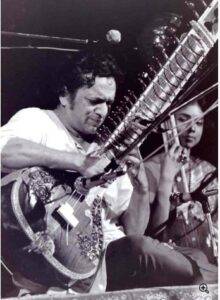In my preceding discussions on the sequential performance of sitar music, I delved into the intricate nuances of the alap, a crucial phase characterized by its free-flowing, unrhythmic nature. Within the alap, the jod assumes a pivotal role, serving as the rhythmic section that introduces a semblance of structure to the otherwise unbounded melodic exploration. The jod can be viewed as the instrumental counterpart to the nomtom found in the dhrupad vocal tradition of Indian music. Both the jod and nomtom share a common feature—a simple pulse. However, what distinguishes them is the absence of a clearly defined rhythmic cycle. This unique characteristic allows for a flexible and fluid expression, creating a mesmerizing interplay of melodic patterns and rhythmic elements. The jod serves as a bridge between the free-form alap and the more structured rhythmic sections that follow in sitar performance. It introduces a subtle sense of pulse and rhythm, paving the way for the gradual transition into more intricate rhythmic cycles. This rhythmic interlude adds a layer of complexity to the overall musical narrative, contributing to the immersive and evolving journey that is characteristic of sitar performances.
The jod stands as a canvas where each gharana, or stylistic school, revels in the liberty of showcasing its distinct musical identity. Within the expansive realm of jod, diversity flourishes, and every style of sitar or sitar playing unveils its unique nuances. Various traditions draw inspiration from different sources; some are influenced by the emotive intricacies of dhrupad singing, embedding the melodic richness and ornamentation found in the classical singing traditions. In contrast, others intricately weave the aesthetic intricacies of khyal singing onto the framework of dhrupad, creating a fusion that captures the essence of both forms. Additionally, certain gharanas proudly embrace the legacy of the been, infusing the resonant and ancient tonalities associated with the been playing. This proud adherence to diverse musical influences within the jod not only reflects the rich tapestry of Indian classical music but also allows each gharana to carve out its unique artistic signature. The distinctive ornamentation and stylistic elements inherent to each tradition contribute an additional layer of beauty and complexity. This phase becomes a canvas where the unique embellishments of particular styles enhance the overall aesthetic of the performance. As artists delve into the exploration of the jod, the choice between ulta jhala and seedha jhala becomes a significant aspect, each carrying its own set of stylistic implications. Some traditions gracefully navigate the jod with the ulta jhala, creating a mesmerizing interplay of inverted strokes, while others equally captivate with the seedha jhala, utilizing straightforward yet intricate patterns to weave a tapestry of musical expression.
Furthermore, it is in the jod that the specific taans, or musical phrases, unique to each style, come to the forefront. These taans serve as the hallmark of the jod section, embodying the essence of the particular tradition and adding a distinctive flavor to the overall composition. The nuanced execution of these taans enhances the emotive quality of the performance, showcasing the virtuosity of the sitarist within the framework of the rhythmic and melodic interplay of the jod. This phase becomes not only a showcase of technical prowess but also a testament to the diversity and depth present in the various stylistic traditions within the realm of sitar playing.

As the foundation of the jod in sitar music is deeply rooted in Dhrupad, and it thrives on the unbridled rhythmic expressions aligned with the pulse of Dhrupad-based taals, such as dhamar and chautaal. This phase serves as a rhythmic extension of the Dhrupad tradition, allowing for seamless integration of unbound rhythmic flows within the framework of these Dhrupad taals. In the exploration of the jod, there have been instances where musicians introduce accompaniment. Notably, the accompaniment often features the “bada mukh” tabla or occasionally the pakhawaj. The addition of these percussion instruments adds a layer of depth and resonance, creating a captivating synergy between the intricate sitar melodies and the rhythmic patterns produced by the accompanying percussion. The utilization of Dhrupad-based taals and the incorporation of accompaniment in the form of the “bada mukh” tabla or pakhawaj serve to expand the sonic palette of the jod. This fusion of melodic and rhythmic elements not only pays homage to the traditional roots of Dhrupad but also allows for a dynamic and evolving expression within the jod section of sitar music. The resulting musical journey becomes a harmonious blend of tradition and innovation, showcasing the adaptability and creativity inherent in the artistry of sitar players.
Mastery of the jod section demands a high level of proficiency in both rhythm and the nuanced techniques of the right and left hands. The intricate rhythmic patterns inherent in Dhrupad-based taals, such as dhamar and chautaal, necessitate a keen sense of timing and precision in execution. On the one hand, the right hand, responsible for plucking the strings, must navigate through complex taans and ornamentations, requiring dexterity and finesse. The sitarist’s ability to articulate melodic phrases with clarity and fluidity is crucial to convey the emotive depth of the jod section. Conversely, the left hand, governing the placement of fingers on the frets, plays a pivotal role in achieving the desired pitches and executing intricate musical phrases. The artist’s command over left-hand techniques, including meend (gliding between notes) and gamak (ornamental slides), contributes to the expressive richness of the jod. The synergy of rhythm and technique in the jod section represents a formidable challenge, demanding a harmonious balance between the rhythmic intricacies of Dhrupad-based taals and the virtuosic execution of melodic phrases. It is through the seamless integration of these skills that sitar players bring forth the enchanting beauty and complexity inherent in the jod, making it a captivating and integral segment of sitar music performance.